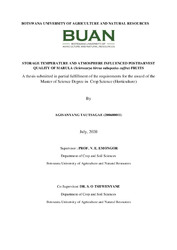| dc.description.abstract | Low temperature storage is the most effective technology for maintaining quality and extending the postharvest life of fresh horticultural produce. However, horticultural produce of tropical and subtropical in origin are susceptible to chilling injury (CI) when stored at temperatures below their critical minimum temperatures. Therefore, low temperature storage alone is not suitable for produce of tropical and subtropical in origin. This study was carried out to evaluate the influence of storage temperature and atmosphere on postharvest quality of marula fruits during and after storage. The treatments were storage temperature (6, 8, 10, 12 and 25°C) and storage atmosphere (MAP and Air). The results of the study showed that the steady state equilibrium in MAP was significantly (P < 0.05) influenced by storage temperature. The steady state equilibrium was reached after 4, 6, 8 and 9 days in MAP fruit stored at 12, 10, 8 and 6ºC. Storage temperature and atmosphere interactered significantly (P < 0.05) to lower the respiration rate of marula fruit compared to fruit stored in Air. Storage temperature below 12ºC significantly (P < 0.05) increased CI incidence, CIseverity and proline content of marula fruit. As storage temperature decreased below 12°C, the incidence and severity of CI, and proline content increased. Marula fruit in MAP and stored in various temperatures had significantly (P < 0.05) lower electrolyte leakage than fruit stored in Air. Storage temperature significantly (P < 0.05) influenced fruit quality (fruit colour, titratable acidity (TTA), juice pH, soluble solids content (SSC), and vitamin C contnet). Temperatures below 12ºC delayed and retarded marula fruit colour development, reduced SSC, increased TTA and juice pH. Fruit stored at 6ºC had significantly (P < 0.05) higher vitamin C content of 92 mg/100 ml juice than fruit stored at 8, 10, 12 and 25ºC. Storage temperature and atmosphere significantly (P < 0.05) interacted to influence fruit weight loss. Marula fruit in MAP and stored at lower temperatures had significantly (P < 0.05) lower weight loss than fruit held in Air. The results further showed that marula fruit stored at 12˚C in MAP had significantly longer shelf-life of 21 days than fruits in Air stored at 6, 8, 10 and 12˚C which had a shelf-life of 12, 13, 15 and 19 days, respectively. It was concluded that in order to reduce marula fruit CI incidence and severity, maintain fruit quality, and extend shelf-life and the marketing period; the fruit should be stored in MAP and at 12°C. However, it was also recommended that this study be repeated with other MAP technologies such as waxing and low density polymeric films with different porosities. | en_US |

